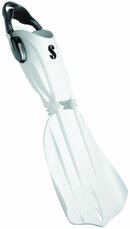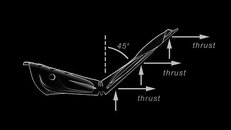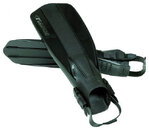sharksdelight
Contributor
ScubaPro’s SeaWing Nova Dive Fins
MSRP $189.00
Review by Steve Douglas
In the early days of scuba diving there weren’t very many fin designs that differed from one another. When I first started diving in the early 80’s it was the Scuba Pro Jet Fin that I and all my dive buddies jumped in the water with. Some of them are still using the Jet Fin today as it was extremely durable and went on and off your foot with ease.
They used a paddle design and were quite durable.
In the early 90’s I owned a dive shop and, therefore, had the opportunity to dive many different types of fins from several manufacturers. Most of the fins did a decent job in terms of propulsion and stability in the water, but the one thing that stood out was that they were all a heck of a lot lighter in weight than were the Jet Fins. At the time this really didn’t mean a lot to me as the airlines had not started charging for more than two checked bags and the weight limits were 70 lb. each.
However, in todays world of decreasing weight allowances by the airlines the Jet Fins simply prove to be too heavy by todays fin standards.
Since then, many new designs of fins have reached the market that revolutionized diving in many ways. Scuba Pro produced their split fin design a few years ago and its added thrust and exemplary hovering ability made it my number one choice for diving for several years.
Traditional bladed fins created their thrust by the divers exertions against the drag caused by the bladed fins. Thus, while the bladed fins worked fine, the diver, knowingly or not, needed to exert herself more thereby additionally increasing their air consumption.
Constantly focused on improving upon their own technological achievements and retaining their name as the most widely known of all scuba equipment manufacturers, Scuba Pro introduces the SeaWing Nova fin.
The Sea Wing Nova is a further advancement in fin design characterized by an articulated joint similar to the tail joint of a dolphin. This permits the fin’s ribbed blade to pivot in the water creating less drag while generating additional thrust. In layman’s terms, when you bring your leg on a downward stroke, the bottom half of the fin snaps down generating additional thrust. The same applies to the upstroke, bring your leg up and the bottom half snaps up. You don’t feel this occurring, you just notice that your speed underwater has significantly increased over the fins you had been using.
One thing I loved about the ScubaPro Sea Wing Nova is the ease of slipping them on and taking them off. I have always disliked fins whose strap you had to snap in or out to take the fin off. I have been in the water many times waiting for someone fumbling with their fin strap while on the dive ladder.
The Sea Wing Nova uses a marine grade rubber strap with an elastic bungie inside to make putting on or taking off the fins super quick and easy. No adjustments to constantly make to the straps. No tightening and loosening, tightening again and loosening again.
Additionally, the open heel foot pocket was as comfortable as the best I have used. While the Seawing Nova comes in black, being a videographer I chose the white version which enables me to white balance my camera underwater as lighting situations change. No more white slates to carry around and hold up while your subject swims away.
4 here
The ScubaPro SeaWing Nova fin has now become my number one choice of fins. At the risk of being redundant, I love that it is light in weight, provides excellent thrust as well as a steady hovering ability, and is so easy to put on and take off. It has earned my highest of recommendations.
Steve Douglas is a certified Apple Pro for Final Cut Pro 7 and underwater videographer. A winner of the 1999 Pacific Coast Underwater Film Competition, 2003 IVIE competition, 2004 Los Angeles Underwater Photographic competition, and the prestigious 2005 International Beneath the Sea Film Competition, where he also won the Stan Waterman Award for Excellence in Underwater Videography and 'Diver of the Year', Steve was a safety diver on the feature film "The Deep Blue Sea", contributed footage to the Seaworld Park's Atlantis production, and productions for National Geographic and the History channels. Steve was a feature writer for Asian Diver Magazine and is one of the founding organizers of the San Diego UnderSea Film Exhibition. He is available for both private and group seminars for Final Cut Pro and leads underwater filming expeditions and African safaris with upcoming excursions to the Cocos Islands, Costa Rica, and Hawaii. Feel free to contact him if you are interested in joining Steve on any of these exciting trips. www.worldfilmsandtravel.com
MSRP $189.00
Review by Steve Douglas
In the early days of scuba diving there weren’t very many fin designs that differed from one another. When I first started diving in the early 80’s it was the Scuba Pro Jet Fin that I and all my dive buddies jumped in the water with. Some of them are still using the Jet Fin today as it was extremely durable and went on and off your foot with ease.
They used a paddle design and were quite durable.
In the early 90’s I owned a dive shop and, therefore, had the opportunity to dive many different types of fins from several manufacturers. Most of the fins did a decent job in terms of propulsion and stability in the water, but the one thing that stood out was that they were all a heck of a lot lighter in weight than were the Jet Fins. At the time this really didn’t mean a lot to me as the airlines had not started charging for more than two checked bags and the weight limits were 70 lb. each.
However, in todays world of decreasing weight allowances by the airlines the Jet Fins simply prove to be too heavy by todays fin standards.
Since then, many new designs of fins have reached the market that revolutionized diving in many ways. Scuba Pro produced their split fin design a few years ago and its added thrust and exemplary hovering ability made it my number one choice for diving for several years.
Traditional bladed fins created their thrust by the divers exertions against the drag caused by the bladed fins. Thus, while the bladed fins worked fine, the diver, knowingly or not, needed to exert herself more thereby additionally increasing their air consumption.
Constantly focused on improving upon their own technological achievements and retaining their name as the most widely known of all scuba equipment manufacturers, Scuba Pro introduces the SeaWing Nova fin.
The Sea Wing Nova is a further advancement in fin design characterized by an articulated joint similar to the tail joint of a dolphin. This permits the fin’s ribbed blade to pivot in the water creating less drag while generating additional thrust. In layman’s terms, when you bring your leg on a downward stroke, the bottom half of the fin snaps down generating additional thrust. The same applies to the upstroke, bring your leg up and the bottom half snaps up. You don’t feel this occurring, you just notice that your speed underwater has significantly increased over the fins you had been using.
One thing I loved about the ScubaPro Sea Wing Nova is the ease of slipping them on and taking them off. I have always disliked fins whose strap you had to snap in or out to take the fin off. I have been in the water many times waiting for someone fumbling with their fin strap while on the dive ladder.
The Sea Wing Nova uses a marine grade rubber strap with an elastic bungie inside to make putting on or taking off the fins super quick and easy. No adjustments to constantly make to the straps. No tightening and loosening, tightening again and loosening again.
Additionally, the open heel foot pocket was as comfortable as the best I have used. While the Seawing Nova comes in black, being a videographer I chose the white version which enables me to white balance my camera underwater as lighting situations change. No more white slates to carry around and hold up while your subject swims away.
4 here
The ScubaPro SeaWing Nova fin has now become my number one choice of fins. At the risk of being redundant, I love that it is light in weight, provides excellent thrust as well as a steady hovering ability, and is so easy to put on and take off. It has earned my highest of recommendations.
Steve Douglas is a certified Apple Pro for Final Cut Pro 7 and underwater videographer. A winner of the 1999 Pacific Coast Underwater Film Competition, 2003 IVIE competition, 2004 Los Angeles Underwater Photographic competition, and the prestigious 2005 International Beneath the Sea Film Competition, where he also won the Stan Waterman Award for Excellence in Underwater Videography and 'Diver of the Year', Steve was a safety diver on the feature film "The Deep Blue Sea", contributed footage to the Seaworld Park's Atlantis production, and productions for National Geographic and the History channels. Steve was a feature writer for Asian Diver Magazine and is one of the founding organizers of the San Diego UnderSea Film Exhibition. He is available for both private and group seminars for Final Cut Pro and leads underwater filming expeditions and African safaris with upcoming excursions to the Cocos Islands, Costa Rica, and Hawaii. Feel free to contact him if you are interested in joining Steve on any of these exciting trips. www.worldfilmsandtravel.com







